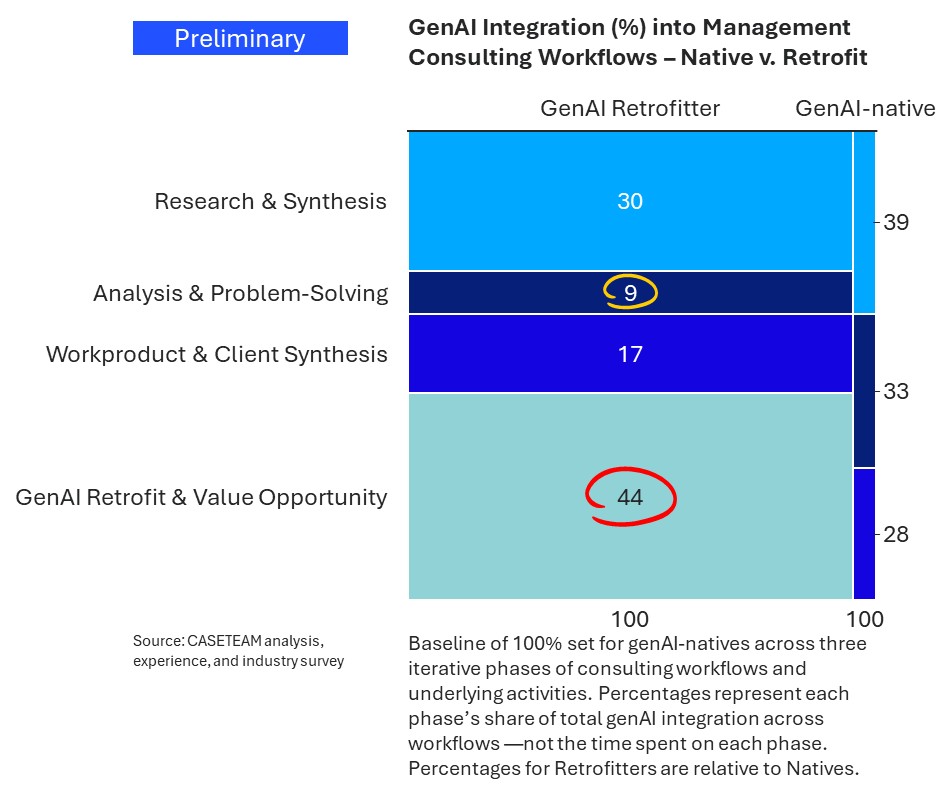

By Srini Bangalore and Cate (genAlyst™)
Every several years, a few academics, journalists, industry watchers, and industry insiders declare that management consulting is on the brink of extinction. Since 2022, the threat they have been writing about has been genAI. The voices appear to have peaked. The logic seems simple: if AI can gather data, generate analyses, and draft reports in minutes, why use consultants? Why not DIY?

But that view is flawed. Management consulting isn’t a product—it’s a service. Services evolve continuously and transform radically in the face of disruptive technologies. Take transportation as a service. The car didn’t kill the need for personal transportation; it replaced the horse and buggy. It made getting places faster, safer, and more efficient. Cars have since changed continuously and kept pace with technology.
GenAI is the car for consulting. It is transforming work, but the need for human insight, judgment, and collaboration remains. What consultants do doesn’t change; how they do it changes – drastically!
The Real Gap: Collaborative Intelligence
CASETEAM’s experience and analysis show that genAI-native consulting firms—built from the ground up with genAI integration—are accelerating ahead. Traditional firms are racing to retrofit genAI into their existing models but will need more time and effort to narrow the gap.
Why? Because the hardest shift isn’t automating research or document creation; it’s integrating genAI into problem-solving.
This is the battleground frontier: Collaborative Intelligence.
The future isn’t human or genAI—it’s human and genAI working together in structured, iterative problem-solving. That’s the unlock. And that’s where the biggest gap remains, especially when scaling problem-solving across teams.
What CASETEAM’s Analysis Reveals
Our analysis examined genAI integration across three iterative phases of consulting workflows and dozens of underlying activities. Exhibit 1 shows how genAI has been integrated into management consulting workflows by genAI-natives and traditional consulting firms that have been retrofitting genAI.
44% of current genAI value remains untapped by traditional firms versus genAI-native firms. A deeper dive into Exhibit 1 shows early wins concentrated in research and synthesis, basic document creation, questionnaires, and interview guides. This signals that the remaining journey, especially in problem-solving and client synthesis, will be harder and take longer.
Our experience emphasizes that genAI has fundamental quality, consistency, and reliability challenges that must be well understood and addressed for the technology to be acceptable for mainstream consulting. However, we also see daily improvements as the competition between leading technology companies intensifies. Consulting firms must make progress in tandem and shape the use of AI technologies in the profession.
Exhibit 1: GenAI Integration in Consulting Workflows – Native vs. Retrofit

Three Big Shifts Underway
GenAI can now produce research in minutes. Clients no longer need consultants just to deliver information. But data is not a decision.
The shift: Consultants are needed to help clients interpret insights, navigate trade-offs, and act decisively, just like in the past, only faster and better. Collaborative Intelligence unlocks this. GenAI structures data; humans shape the recommendation.
Pages have long been the output of consulting firms. Pages will remain – but clients will increasingly demand live, dynamic answers.
The shift: Clients want pages faster, supplemented by interactive models, adaptive dashboards, and tools that evolve with their needs. GenAI enables it. Consultants orchestrate it.
GenAI is automating entry-level tasks like research and first-draft analysis. But that work was never the goal—it was a necessary training ground.
The shift: Consultants must advance faster into judgment-heavy work – orchestrating genAI, crafting recommendations, and driving client alignment and outcomes.
The Risk? Standing Still
GenAI isn’t the threat to consulting. The threat is failing to self-disrupt.
Firms clinging to manual-intensive workflows and old operating models will fall behind. Clients expect speed, precision, and better decisions. Firms that integrate GenAI across research, problem-solving, and client synthesis will lead. Those who do not will be left fixing horse buggies or low-power cars.
CASETEAM’s Recommendations

Final Word: GenAI Is Strengthening Consulting—Not Eating It
Consulting is not a product; it’s a service. GenAI is a new high-performance engine powering that service.
The firms that master Collaborative Intelligence—human ingenuity and genAI acceleration—will lead the future and drive positive client impact.
The rest will watch from the roadside while figuring out how to catch up. CB
Last update: Feb 16, 2025

By Srini Bangalore, Founder & Chief Client Officer | Cate, genAlyst

CASETEAM Launches as GenAI-native and Hybrid-first Management Consulting Firm, Innovating a New Model that Makes Top-tier Problem-solving Accessible to More Organizations
By Integrating GenAI with Human Ingenuity, CASETEAM Creates a New Model for Management Consulting

Q&A with Cate, genAlyst at CASETEAM
[Note: Cate is a genAI model configured for the needs of CaseTeam]


By Srini Bangalore, Founder and Chief Client Officer

What the Paul Weiss Case Reminds CEOs and Boards About Stakeholder Alignment
By Srini Bangalore, Founder & Chief Client Officer

The U.S. Congress’s mandate that ByteDance divest TikTok or face a ban is a significant development in global tech regulation.

The $24.6 billion Kroger-Albertsons merger, announced in 2022, aimed to create a grocery powerhouse to compete with Walmart and Amazon. However, regulatory opposition and public backlash…

Mergers and acquisitions are among the most transformative moves a company can make to accelerate growth — but it is commonly known that 70% or more of M&A transactions fail …

In today’s highly interconnected economy, supply chain resilience is no longer just a defensive strategy…










Share this Post